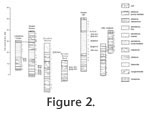|
|
|
GEOLOGIC SETTING
As noted by Lindsay et al. (2002) the stratigraphic-chronologic framework for the Panaca Fm. is constrained by an ash bed that overlies the author's highest small mammal site and has been identified as the Healdsburg Tephra by A. Sarna-Wojcicki of the USGS (Menlo Park). That tephra has been dated at 4.69 Ma, using the 27.84 Ma monitor for the Fish Canyon sanidine interlaboratory standard. All of the small mammal sites currently known from the Panaca Fm. are considered early Blancan NALMA whereas the large mammals reported from the Panaca Fm. by Stock (1921) are considered Hemphillian NALMA. Based on the location given by Stock (1921), the author believes the fossils collected and reported by Stock were from stratigraphic levels below our lowest small mammal site (e.g., in magnetozone B+) in the Little Hogback section in Figure 2. Note that the rate of sediment accumulation in the Little Hogback section is lower than in the other sections as it is farther from the edge of the basin where most of the fossil sites are located. Very thorough search of the lower exposed strata in the area of the Little Hogback section did not locate any identifiable fossils or any sediment that would yield small mammals. See Lindsay et al. (2002) for more details on the geology and chronology of the Panaca l.f. |
|
